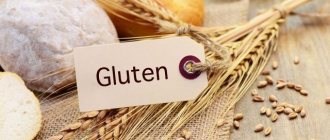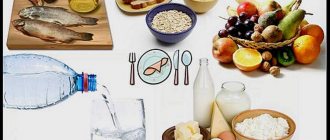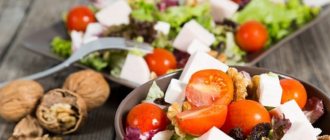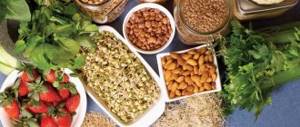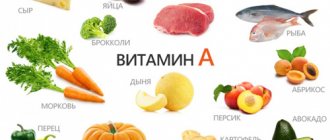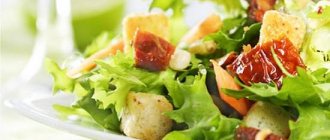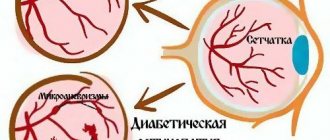Duration and exit rules
Medical nutrition is prescribed for various diseases.
You must adhere to the diet for at least one month. If the patient's condition has not improved, the uric acid level is still high, the diet is extended.
Treatment should be supervised by a doctor. Only he can tell you when you can go off the diet.
If the doctor has given permission to withdraw from medical nutrition, the patient can slightly increase the portions and include prohibited foods in the menu in small quantities.
However, it is recommended to continue to eat properly so that the disease does not reappear.
A diet for high uric acid is incredibly effective and allows you to achieve recovery. Following the rules of therapeutic nutrition, the patient will recover.
This is one of the best ways to fight the disease, allowing you to recover quickly.
If a patient's gout progresses, in order to live without pain, it is necessary to choose an antipurine daily diet, that is, to minimize the presence of this acid in the daily menu. To do this, you can choose a strict vegetarian diet or not be categorical and adhere to the following medical recommendations:
- Eliminate protein foods from the daily menu as much as possible, since protein metabolism increases the concentration of urates in tissues.
- Drink plenty of fluids, which reduces the concentration of uric acid and promotes the elimination of salt naturally.
- Reduce your consumption of table salt as much as possible, choose fresh and lean dishes without adding spices.
- It is very important to eliminate the feeling of hunger, so the diet can be reasonably high in calories and satisfying. Stop fasting immediately, otherwise a gout attack is guaranteed.
- It is important to remember the list of permitted and prohibited foods, since you will have to adhere to the updated diet throughout your life.
Doctors' opinions
If the level of uric acid in the blood is high, experts strongly recommend following dietary rules.
The right selection of products can speed up the healing process.
In combination with drug therapy, dietary control shows the highest effectiveness.
Doctors note that the main reasons for increased uric acid levels are heredity, excess weight and poor nutrition.
Based on the opinions of doctors, the following conclusions can be drawn:
- in the presence of pathologies associated with increased levels of uric acid, you must adhere to the dietary program throughout your life;
- under no circumstances should you conduct experiments on your health and deviate from the established nutrition schedule;
- a diet designed to normalize the level of uric acid in the blood can be followed for preventive purposes;
- non-compliance with the dietary program can shorten the patient's life expectancy.
Diet for high uric acid in women
A diet for high uric acid in women is becoming increasingly popular. If earlier this ailment was characteristic mostly of men, then in the last few years, for example, women have often begun to suffer from gout. Following a diet and taking a drug such as Purinol (Allopurinol) gives excellent results already in the first month.
If a woman does not tolerate the diet very well, the doctor may prescribe treatment only in the form of medication. However, it must be remembered that the effect of such therapy will not be noticeable soon.
Since a characteristic disease progresses much more often in the female body with age (during the upcoming menopause), patients should clearly understand that overall well-being, performance, physical activity and emotional stability depend on a properly selected diet. The diet for gout on the legs provides the following rules for the treatment of representatives of the fairer sex:
- The diet includes 5-6 meals. These are three main meals with a hearty breakfast, plus additional snacks throughout the day.
- The doctor very precisely stipulates the norms of certain products, and it is important not to violate them. For example, boiled meat for gout can be eaten only 3 times a week, no more.
- In the absence of extensive pathologies with the kidneys, a patient with gout is allowed to drink up to 3 liters of fluid per day.
Indications for diet
Excessive uric acid in the blood provokes the formation of sodium salts in the body. This condition can develop asymptomatically over a long period of time. With a large accumulation of salts, the functioning of joints and vital systems occurs. Indications for following a diet are not only specific diseases, but also a slight deviation of uric acid in the blood .
Indications for following the diet:
- congenital form of hyperuricemia;
- any stages and forms of gout;
- congenital metabolic disorder in the body;
- long-term use of drugs for the treatment of tuberculosis;
- leukemia;
- eczema;
- typhoid fever;
- psoriasis;
- tuberculosis;
- liver pathologies;
- different stages of diabetes.
Uric acid can increase with frequent strict diets and heavy physical activity.
If such factors are present, the nutrition program is followed until test results normalize.
If the cause of the increase in the level of this substance is illness, then you will have to follow an adjusted nutritional schedule for a long time. A similar rule applies to the consequences of taking certain medications.
Basic principles of nutrition
- You need to consume a lot of water. It will remove salts from the body naturally and make the patient feel better.
- You should avoid salt, spices, and food additives. Food should be fresh, without excesses.
- Fasting is excluded, you need to eat every 2-3 hours, otherwise an attack of joint pain is guaranteed.
- Fatty, fried and floury foods are immediately excluded from the diet.
- Meat consumption is reduced. Choose low-fat varieties: beef, veal, turkey or chicken.
- Sweet carbonated drinks are replaced with herbal infusions, compote, and fruit drinks.
The main rule of cooking is to avoid frying. Products are prepared by steaming, boiling or baking. Daily calorie content is from 2500 to 2800 kcal, weight is 2.3-2.8 kg.
You need to eat 5-6 times a day. If you feel hungry, you need to have a snack. You cannot tolerate hunger - it will only worsen the condition.
Nutritionists call essential foods - they remove uric acid from the body. These include apples, potatoes, plums, and pears.
The diet for high uric acid is not as strict as for a number of other disorders, but it requires taking into account some factors, without which you can forget about successfully achieving the desired result.
It is important to understand that the content of harmful elements in urine directly affects the development of all kinds of diseases. If you regulate their quantity, you can reduce the concentration of uric acid without extra effort. Principles to adhere to:
- it is necessary to switch to fractional meals - 3 main meals and two snacks. For those who have been adhering to the principle for a long time: “first I’ll be patient, and then I’ll eat at once for the whole day,” it will not be easy to adapt. However, this is necessary to normalize the amount of uric acid. This is not only due to the fact that it is difficult for the gastrointestinal tract to cope with large amounts of food at one time. The fact is that with elevated uric acid in the blood of women, it is necessary to reduce the amount of purines. Fractional meals allow the body to calmly get rid of them, and uneven food intake will lead to their accumulation;
- the amount of protein in the diet should be reduced. To do this, the amount of meat, fish and legumes in the diet must be reduced, which will have a beneficial effect on the acid content. Fermented milk products will help replace them;
- Exceeding the required amount of proteins and fats will interfere with the removal of uric acid from the body. The rate of fat consumption is no more than 1 gram per 1 kilogram;
- in case of obesity, it is necessary to try to normalize weight. However, you should not do this too abruptly, since the body will not have time to rebuild itself, and the accumulated purines will not go anywhere. Losing weight by 1 kilogram per week is considered optimal;
- fasting and strict diets are unacceptable in this case. If adequate nutrition stops entering the body, useful substances from certain foods will also stop coming along with it. The body will need to use previously accumulated proteins and fats, and as a result of their breakdown, uric acid appears;
- It is recommended to occasionally arrange fasting days. This term does not mean fasting or not eating, but rather eating only certain foods during the day, such as vegetables, fruits or dairy products. Such days can be arranged no more often than once a week;
- You should not focus on other diets, as in this case some foods can cause additional harm. For example, not everyone knows how many purines remain in ordinary broth. When cooking meat or fish, these substances end up in the broth, so you should avoid using it.
Also, do not forget about some classical requirements. It is necessary to reduce the amount of salt consumed, which interferes with the removal of water from the body. You need to pay special attention to the water itself and drink 2 liters a day. Alcohol should be avoided, especially beer. A small amount of wine is allowed, but no excess.
The therapeutic diet is introduced against the background of drug therapy. The diet reduces the intake of purines from food, normalizes their metabolism, and reduces the intensity
the formation of colorless crystals, shifts the pH of urine to the alkaline side.
The duration of nutritional therapy depends on the cause of hyperuricemia. The minimum period of the diet is 2 months, the maximum is the entire period of illness.
The diet is strict, because any deviation from the instructions can cause a jump in acid concentration. Principles of antipurine nutrition:
- When uric acid in the blood is high, foods rich in purines and oxalic acid are sharply limited.
- The menu contains plenty of water, healthy drinks and food that alkalinizes the blood.
- The diet includes foods rich in calcium, potassium, and alkaline valencies.
- The number of fractional meals is 5-6; in between, you must take liquid (up to 2.5 liters per day).
- Once a week, it is recommended to spend fasting days on cottage cheese, milk, kefir or fruit, but the patient should not feel hungry.
- During diet therapy, meat and fish must always be boiled first and then cooked in the desired manner (except for frying in oil). When cooked, 50% of the purines pass into the broth.
- Meat and fish dishes are consumed 2-3 times a week. The serving size of meat does not exceed 150 g, fish - 170 g.
- You need to eat a lot of fruits, they reduce the concentration of purine metabolism products. They should be consumed 1 hour before meals or 3 hours after.
Diets to reduce uric acid
When the level of uric acid in the blood serum increases, the diet is adjusted by resorting to diets:
- No. 6 according to Pevzner - used to treat gout;
- No. 5 according to Pevzner - used for diseases of the liver and biliary tract.
Diet No. 6 is prescribed for urolithiasis, when uric acid salts accumulate and crystallize in the kidneys. The same nutritional principles are used in diets to reduce the level of uric acid when its content in the blood is high.
The meat of young animals, as it contains the most purine bases, offal, fish, canned fish and meat is excluded from the diet. Legumes, rich soups, and mushrooms are not recommended.
Daily fluid intake should be maintained within 1.5 - 2.5 liters. Such a wide range of values is explained by the fact that in some diseases, for example heart failure, the daily volume of fluid is limited to 1.2 - 1.5 liters.
If the kidneys and heart are healthy, and there are no other contraindications, then fluid intake per day can be 2.5 liters. According to diet No. 6, they reduce the amount of salt in the diet and exclude hot seasonings and spices.
With obesity, the intake of fat is reduced, and the calorie content of the daily diet is reduced. Avoid fatty meats, fish, and high-fat dairy products.
Animal fat increases uric acid, which is why it should be eliminated or significantly limited. But lemon, grapefruit and other citrus fruits, alkaline mineral waters, on the contrary, help reduce uric acid.
In the diet of a patient with elevated levels of uric acid in the blood, citrus fruits must be present on the menu for a week, if not daily, then 3-4 times. A few slices of fruit are enough to get a positive result.
Hyperuricemia is often accompanied by unsatisfactory condition of the liver and biliary tract. In this case, the doctor may recommend diet No. 5 according to Pevzner with some amendments:
- reduction in the diet of meat and fish;
- introduction of vegetarian dishes 2 days a week;
- increasing daily fluid intake to 2.2 liters.
Elevated uric acid is usually associated with obesity. In this case, reduce the caloric content of the diet, limiting sweets in the diet.
High levels of sUA may accompany heart disease. The basis of therapeutic nutrition in this case is diet No. 6, in which:
- limited daily fluid intake;
- reduced salt intake;
- Products containing potassium and magnesium are additionally introduced.
What to exclude from the diet for hyperuricemia
You should be careful when using foods that interfere with kidney function in your diet. An indicator of the effectiveness of kidney function is the level of urea in the blood.
When choosing the right diet for women and men, especially the elderly, in the case of high uric acid, the doctor also prescribes a test to determine the urea content in the blood.
Avoiding sugar will help reduce uric acid in the body. If, however, you want something sweet, you can replace it with honey.
Uric acid in the blood is elevated if there is an excess intake of fructose in the diet, both in the form of a food additive and as part of sweet fruits and berries.
It is important to limit salt in the diet, but not to give it up completely, since most of the territory of the Russian Federation is located in iodine-deficient areas. And iodized salt is one of the constant sources of iodine.
In addition, the condition of hyponatremia is very dangerous and can lead to coma.
Diet for gout with obesity
To reduce the concentration of uric acid, the patient must get used to the regimen and eat at regular intervals. However, each clinical picture has its own individuality. For example, obesity of one degree only intensifies an acute attack of pain due to gout, however, starving is extremely dangerous. The optimal solution is dietary table No. 6, which provides the following rules:
- completely avoid eating fatty, fried and floury foods;
- increase fluid intake to 3 liters per day;
- adhere to a daily vegetarian diet;
- choose bread made from wheat or rye flour;
- do not forget about the enormous benefits of natural vitamins.
Why diet if there are drugs?
Proper nutrition is not only the prevention of diseases, but also the key to their successful treatment. Any doctor, when prescribing medications to a patient, always makes adjustments to the diet or prescribes a special diet. A diet with high uric acid in the blood is especially important.
Pharmacy and traditional medicines, of course, normalize blood counts, but if a person does this against the background of junk food, there will be no benefit from such treatment. Gout is not a death sentence, but no patient is ready to carry this disease throughout his life.
With proper nutrition, a person can gradually and safely reduce uric acid levels. This specific diet will need to be followed throughout your life, since gout is a very insidious disease that tends to recur when the opportunity arises.
Find out more about gout and how to treat it here. Breaks in this eating regimen are extremely undesirable, especially if the disease is in a severe stage. Any deviation from the prescribed diet may worsen the patient's condition. A diet during an exacerbation of gout will be fraught with more stringent rules.
Its effect on the body
To cleanse the blood and productively remove oxalic acid from the affected body, a therapeutic diet with fasting days is necessary. In the latter case, we are talking about the recommended period when it is possible to restore the chemical composition of the blood without the participation of medications. Here are some foods that can remove uric acid from the body:
- plums;
- pears;
- apples;
- potato;
- apricots.
A diet to reduce uric acid in the blood (or joints) has a beneficial effect on the functioning of the entire body. It reduces the level of uric acid, removes salts from the body, and cleanses it.
There is a saturation with vitamins and minerals, which increase protective properties and immunity.
The health of the joints is restored, the person will be able to move a lot without feeling pain. His condition will improve, he will feel a surge of strength and energy.
Metabolic processes are normalized, and the likelihood of recurrence of the disease is reduced. I manage to stay healthy and feel great.
- Fruits: apricots, peaches, apples, plums, pears, bananas.
- Vegetables: potatoes, zucchini, carrots, beets.
- Berries: strawberries, currants, lingonberries, gooseberries.
- Dried fruits: dates, raisins, prunes.
- Porridge: buckwheat, oatmeal, rice, millet, semolina, corn.
- Sweets: honey, marshmallows, marshmallows, marmalade.
- Meat: beef, veal, chicken, turkey.
Dairy products are allowed: cottage cheese, kefir, yogurt, fermented baked milk. In small quantities - sour cream, cream and boiled eggs.
To dress salads, you should use olive or sunflower oil. Natural yogurt, which does not contain sweeteners or dyes, is also suitable.
- Vegetables: cabbage, onions, cucumbers, radishes, tomatoes, garlic, sorrel.
- Fruits: pineapples, kiwi.
- Mushrooms.
- Sweets: candy, cake, chocolate.
- Food additives: spices, salt, sugar, ketchup, mayonnaise.
- Meat: pork, lamb, lamb, duck, goose.
You should avoid fish, seafood, and caviar. You cannot consume cakes, pastry cream, cocoa powder, cakes, chocolate.
Alcoholic and sweet carbonated drinks, flour, legumes, and mushrooms are prohibited. You should not add dill, parsley, onions and garlic to your food.
A diet for high levels of uric acid in the body should be prescribed by a specialist, since the choice of dishes directly depends on the specific case. However, there are a number of acid-reducing foods that you should include in your diet. Among the foods you can eat:
- vegetables and fruits, which are allowed to be consumed in unlimited quantities. Citrus fruits are especially worth highlighting. Even if you already eat fruits, the amount in your diet can be increased;
- dairy products will become an indispensable assistant as the main source of protein. It is better to eat low-fat foods;
- Mineral water or green tea are excellent as a regularly consumed liquid. This also includes black tea, juices and fruit drinks, but they should not be abused;
- Allowed foods include eggs, but you can eat no more than 2 of them per day;
- even boiled fish and meat can be consumed without fear, it is only important to change the water several times during the cooking process, which will allow you to get rid of most of the purines;
- foods such as cereals, pasta or butter should be consumed in limited quantities;
- if you want something sweet, you can always eat pudding, jelly or some kind of fruit dessert.
By including vegetables and dishes that include green onions in your menu, you can normalize the level of uric acid in the body.
There are a number of foods that increase uric acid. At first it will not be noticeable, but soon excess uric acid in the body will lead to the appearance of gout or another equally dangerous disease. The list of prohibited foods is small, but every person who cares about their health should know what they should not eat:
- As noted above, the list of foods to avoid includes broths. It is in broths that the content of harmful purines is very high;
- Fried and smoked foods should also be avoided. If you want to eat meat or fatty fish, just boil or steam them. These are the most harmless cooking methods, which also allow you to preserve the natural taste of the food;
- among drinks it is worth noting not only alcohol, but also coffee;
- Unfortunately, most of the sweets that we all love so much contain harmful substances. Therefore, chocolate, honey, pastries, and cakes are prohibited;
- Reduce your intake of sorrel, radishes and cauliflower. These products, despite their obvious usefulness, interfere with the removal of purines from the body.
Eating fish and legumes, just like meat, is not prohibited. It is only important to adhere to certain rules that will not be difficult to get used to.
Permitted and prohibited products
If uric acid in the blood is high, it is allowed to consume not only all types of vegetables and fruits, but also products based on them (purees, sauces, jams, mousses). Seafood is allowed to be included in the diet, but in limited quantities. For drinks, it is recommended to drink teas, decoctions based on medicinal plants, compotes and freshly squeezed juices.
Authorized products:
- fermented milk products;
- low fat dairy products;
- cereals;
- rabbit meat;
- chicken;
- turkey;
- pasta;
- fruits;
- citrus fruits;
- greenery;
- eggs;
- honey;
- fruit jam;
- mineral water;
- berries (raspberries are an exception);
- vegetables;
- nuts;
- dried fruits (raisins are an exception).
When preparing dishes, it is necessary to limit the use of salt, spices and seasonings. Any types of smoked meats, marinades and pickles are classified as prohibited.
Confectionery products are excluded from the diet, but sometimes a small amount of dark chocolate is allowed.
If these rules are violated, the effectiveness of the diet may be reduced.
Prohibited products:
- meat of young animals;
- alcoholic drinks;
- confectionery;
- rich meat broths;
- sausages;
- sweet pastries;
- salo;
- aspic;
- grape;
- offal;
- canned food;
- anchovies;
- sorrel;
- mushrooms;
- cauliflower;
- kvass;
- carbonated drinks;
- energetic drinks;
- syrups.
Healthy drinks
If you have gout, you will have to stop drinking alcohol forever, or rather reduce its intake to 100 g “on holidays.” From strong tea and coffee too. It is important to increase your daily fluid intake to 3 liters. We are not just talking about water, you can drink milk jelly (low-fat), berry and fruit compotes, pumpkin, carrot and celery juices, alkaline mineral waters, herbal decoctions. Some people prefer fruit drinks made from apricots, pears and apples - it is also very useful for gout.
Sample menu for the day
Following a diet when uric acid in the blood increases is the key to successfully eliminating the problem. At the same time, you do not need to give up everything at once. The acceptable list of products is wide and allows you to vary the menu depending on your wishes. If we talk about a diet that includes five meals, then a sample menu might look like this:
- For your first breakfast, you can prepare low-fat cottage cheese and tea with milk. It can also be milk with crackers or muesli with kefir. The classic breakfast of oatmeal also remains relevant;
- soon it’s time for a second breakfast, which can be a vegetable salad, a chicken egg with tea, natural yogurt or some fruit;
- for lunch - soup with sour cream, rice with stewed vegetables, boiled chicken fillet, fish soufflé or anything else. Water or tea is suitable as a drink. It is worth noting that eating is not strictly time bound;
- An afternoon snack can consist of a light and tasty dish such as fruit mousse. In this case, there are no serious restrictions, you can even drink coffee with milk, not to mention rosehip decoction. The main thing is not to overeat, limit yourself to a small snack;
- for dinner - dumplings with cottage cheese or potatoes, vegetable soup or omelet.
This is just a sample menu, and everyone is free to create their own diet for the week, based on the basic requirements. In this way, you can not only take care of your own health, but also not limit yourself to eating delicious dishes.
| Day of the week | First breakfast | Lunch | Dinner | Afternoon snack | Dinner | Before bedtime |
| Monday | Oatmeal with prunes | Rose hip decoction | Buckwheat porridge with beef meatballs | Baked apple | Beet salad | Strawberry decoction |
| Tuesday | Boiled egg | Apple | Potato casserole | Natural yogurt | Cottage cheese with berries | Kefir |
| Wednesday | Buckwheat | Pear | Vegetable stew with turkey breast | pumpkin juice | Zucchini puree | Ryazhenka |
| Thursday | Grated carrot salad | Plums | Rice with chicken pieces | Applesauce | Vegetable Salad | Rose hip decoction |
| Friday | Fruit salad | Apricots | Mashed potatoes with veal cutlets | carrot juice | Beet salad | Dried fruits compote |
| Saturday | Oatmeal with pieces of berries | Peaches | Beef with vegetables | Boiled egg | Cottage cheese casserole | Kefir |
| Sunday | Natural yogurt with fruit | Applesauce | Potato and chicken casserole | Tea with marshmallows | Zucchini puree | Curdled milk |
It is recommended to include cereals, vegetables, and fruits in the menu. For breakfast, prepare fruit salads, porridge, cottage cheese with berries. For lunch, small quantities of meat products, vegetables, and casseroles are suitable.
For dinner you can eat vegetable salad, boiled eggs, and dairy products. Before going to bed, you are allowed to drink herbal tea, decoction, kefir, or yogurt.
If you want something sweet, you can snack on herbal tea with marshmallows, marshmallows, honey or marmalade. Other sweets are prohibited. Dried fruits are also suitable for snacking.
To reduce the production of purines and prevent the formation of uric acid, doctors recommend a diet. It is advisable to determine the daily diet together with a professional, thereby protecting your own body from so-called “accidental relapses”. Here is a sample patient menu for the day:
- after waking up - rosehip decoction;
- breakfast – buckwheat with water or skim milk;
- second breakfast – sweet tea with milk;
- lunch - a vegetable dish with the addition of carrots and potatoes;
- afternoon snack – compote, green apple (peanuts are prohibited for gout);
- dinner - fruit salad.
The diet for gout and high uric acid consists of many recipes, but all of them, one way or another, involve consuming only permitted foods and only in permitted quantities. So, for breakfast you can eat a vitamin salad, the components of which are fresh carrots and a peeled apple. The products need to be grated and mixed with a spoon of low-fat sour cream.
Okroshka is also useful during this recovery period. Its composition can be ordinary (radish, cucumber, eggs, potatoes and carrots), and low-fat kefir, low-fat sour cream and a little mineral water can be used as filling. It is useful to drink a decoction of rose hips during the day, eat more apples, for dinner you can eat a potato cutlet, drink weak tea or jelly. If the patient does not have problems with excess weight, it is allowed to eat a piece of marmalade, a spoonful of jam or marmalade, and a little dark chocolate.
Where does uric acid come from?
Uric acid is one of the components of the bloodstream. It is the end product formed as a result of purine metabolism. Purines are nitrogen-containing substances that are found in the cells of the body. These substances include DNA (deoxyribonucleic acid) and RNA (ribonucleic acid).
Uric acid levels must correspond to the following indicators:
- 6 mg/dL for women;
- 7 mg/dl for men.
Purine metabolism is disrupted if the level of uric acid in the blood increases. In this case, a condition called hyperuricemia develops.
What not to eat
| Food category name | Name of food ingredients |
| fresh vegetables | all types of cabbage, mushrooms, sorrel |
| cereals | soy, oatmeal, lentils |
| berries and dried fruits | grapes, raisins |
| legumes | beans, beans, peanuts, peas |
| milk products | salty, spicy, fatty cheeses |
| sweets | cakes, baked goods, homemade baked goods |
| beverages | coffee, cocoa, strong tea, alcohol |
A diet for gout and high uric acid is a balanced therapeutic diet that helps stabilize the condition of the entire body, normalize purine metabolism and reduce the level of urate in the blood.
First of all, purine-rich foods are excluded or minimized from the diet, enriching the menu with healthy foods that help eliminate excess uric acid, including fruits, eggs, milk, fermented milk drinks, alkaline mineral waters and pure spring water.
Diet for gout and high uric acid - what is possible and what is not (food table)
| Product category | Authorized products | Prohibited foods |
| Meat | Low-fat varieties of meat and poultry without skin, cooking method - only boiling and steaming, per week it is permissible to consume 150 grams of white meat or fish no more than 3 times | Meat of all young animals, veal, lamb, suckling pig, fatty meats, offal, all sausages, canned meat, smoked meats, poultry skin, lard, any fried meat products |
| Fish | Boiled lean varieties of fish during the period of remission no more than 2-3 times a week. In case of exacerbation, fish is completely excluded from the diet. | Fatty fish: tuna, salmon, salmon, herring, mackerel, pike perch, vardina, herring, trout, perch and some other types of fish, salted, smoked and canned fish, all types of seafood, caviar |
| Vegetables | Pumpkin, cucumbers, squash, zucchini, potatoes, beets, carrots, turnips, celery, onions, garlic, watercress, artichokes, cabbage (limited), all other vegetables not included in the list of prohibited vegetables, boiled and stewed or steamed | Asparagus, sorrel, spinach, eggplant, radish, corn, early leafy greens, legumes, all types of canned vegetables, including pickled, pickled, salted and other homemade preparations, mushrooms |
| Cereals | Rice, wheat, pasta, rye and wheat bread (in moderation) | Legumes, bran |
| Eggs | Chicken and quail eggs (no more than 1 piece per day) | Fried eggs |
| Fruits and berries | Bananas, figs, citrus fruits, watermelon, melon, persimmon, mango, avocado, plum, peach, apples, pears | Lingonberries, raspberries, rhubarb, cranberries, strawberries, all dried fruits, especially raisins, the only exception being prunes |
| Dairy | Skimmed whole milk, natural yogurt, fermented milk products, low-fat cottage cheese, sour cream, soft unsalted cheese | Fatty foods, salty and spicy cheeses |
| First meal | Vegetarian, lean, cold (okroshka, beetroot soup, gazpacho, tarator) and milk soups, cabbage soup, borscht | Soups prepared in rich or recycled meat, fish and mushroom broths (when meat is cooked, up to 50% of the purines from the product are transferred into the broth) |
| Sauces | Dairy, fruit, vegetable, white sour cream sauces | Ketchup, mayonnaise, everything cooked in meat broth, hot and spicy seasonings |
| Dessert | Berry and fruit jam, marshmallows, marshmallows, natural marmalade, jelly, mousses, honey, jam | Chocolate, cocoa, cakes, pastries, butter cookies |
| Fats | Unsalted butter, cold-pressed vegetable oils (sunflower, olive, pumpkin, sesame, flaxseed, soybean, grape seed, nut) | Animal and cooking fats, margarine |
| Beverages | Non-carbonated alkaline mineral waters, rosehip infusion, green tea, jelly, compotes, citrus fruits and fruit juices diluted with water | Coffee, strong tea, alcohol in any form |
Cannot be consumed
If you have a high uric acid content, there is a list of foods that can increase its level; such foods should be avoided. You will need to avoid sausage, liver, fish prepared by frying or smoking, canned fish and meat. Meat broths, pickles, and sauces with pepper are contraindicated.
Alcohol and strong tea can cause excess uric acid; during a diet, these drinks are excluded from the diet. Baking and baking made from puff pastry is harmful; caution is also required when there is a high level of uric acid; consumption of mushrooms and dishes made from them, sorrel, and cauliflower is required. At the first opportunity, you should avoid dishes with such ingredients. When there is excess weight against the background of increased uric acid levels, fasting days are useful. During this period, the basis of nutrition is milk, fruits, vegetables and dishes made from them.
The list of prohibited products goes on. So, there is a high risk of increasing uric acid levels if you eat corn, chestnuts, and eggplants. Among seafood, you will have to give up sardines, anchovies, tuna and other types of fatty fish. Animal glands, brains, and kidneys should not be eaten. Among poultry, fatty varieties include duck and turkey meat.
How to eat during such a diet?
For therapeutic nutrition to be most effective, it is recommended to eat frequently, but not to overeat, and to eat as varied as possible. The body will receive more vitamins and recover faster.
If the patient does not feel appetite and refuses food, he should be given a herbal decoction or fruit puree.
During the diet, you need to limit your meat consumption, but you don’t get rid of it at all. Portions of meat dishes should be minimal.
To avoid starvation, you should drink plenty of water, fruits and vegetables. Dairy products are also acceptable and should not be avoided.
The patient will gain strength faster if he replaces regular tea with herbal infusion or berry juice.
As usual, you can eat baked or boiled fish, vegetable soups, cereals, pasta (but only from durum wheat), rabbit or turkey meat, flaxseed, olive or sesame oil, and citrus fruits. During an exacerbation, you need to limit yourself to egg whites; in the future, you can eat eggs with yolks.
From dairy products, you should choose those that are least rich in fat. General recommendations during the diet are to drink plenty of fluids and reduce protein foods. If you are obese, it is advisable to get rid of extra pounds, since heavy weight significantly interferes with the recovery process.


